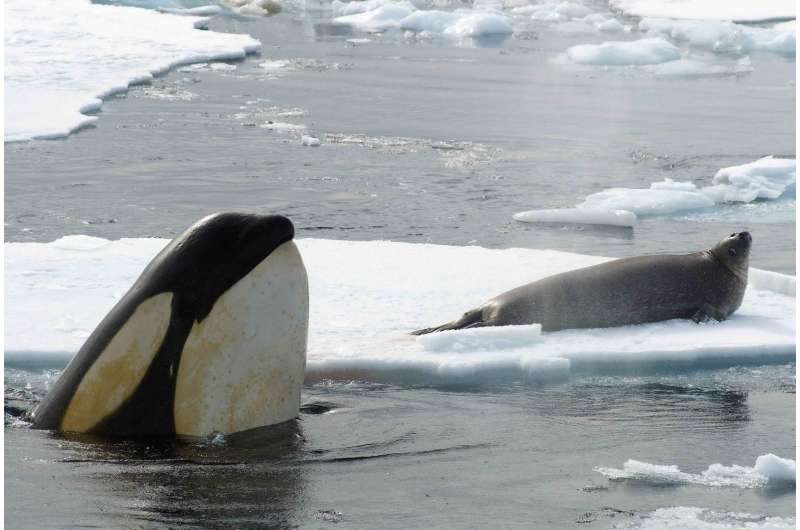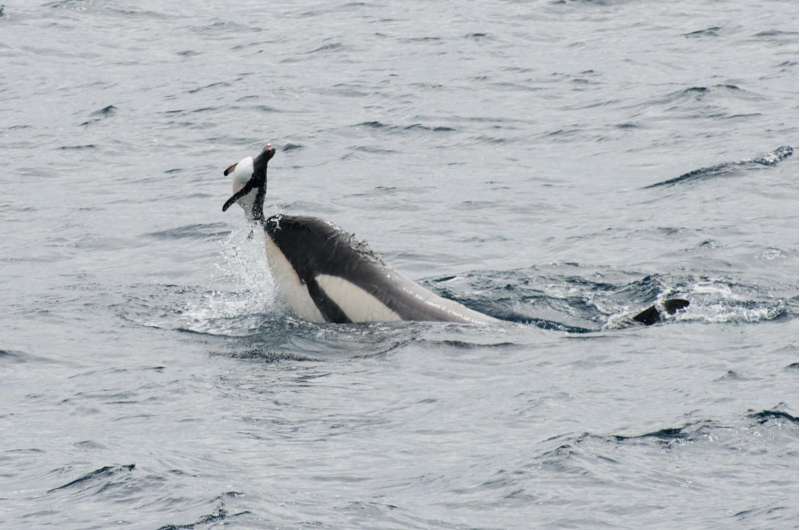Credit: John Durban, NOAA Southwest Fisheries Science Center; research authorized by NMFS (US) permit # 774-1714
(Phys.org)—An international team of researchers has found that killer whale cultural groups have evolved to become genetically distinct from one another. In their paper published in the journal Nature Communications, the team describes how they obtained tissue samples from individual orcas from groups spanning the globe, sequenced the genomes of 50 different individuals and then outline what they found in comparing the results of one group to another.
Scientists have learned over the past several decades that humans have impacted their own evolutionary history by engaging in certain cultural practices—feeding baby's cow's milk, for example, has over time allowed people in some places to become lactose tolerant. In this new study, the researchers have found evidence that suggests that killer whales have followed a similar trajectory.
In studying the genomes of the whales, the researchers found they could classify them into five distinct groups, which the team calls cultures. Each culture has evolved over time an ability to live in a particular part of a given ocean—by catching fish, for example, or birds. Though all of them have evolved from a single ancestor—they began branching off approximately 200,000 years, ago—each culture has its own minor genetic differences. The researchers suggest such differences are partially culturally based because the orcas passed on survival techniques to their young—techniques that wound up influencing the groups so strongly that they have become part of their DNA. The process is similar to that for humans, the researchers report, which does not seem to be coincidental. Both species inhabit areas across the globe—orcas live in every ocean, humans live on every continent. Also, both provide parental support for decades and have similar life-spans. It is the breadth of occupied territory, though, that has caused such differences between cultures, the team believes, as different groups learned over hundreds of years how best to survive in a new place.
In studying the genome data, the researchers discovered that it appears likely that originally, orcas lived in just one place, but over time, some individuals ventured farther from home and managed to survive. Those hardy individuals in turn conveyed necessary skills to their offspring which allowed for the growth of a new group, which over many years resulted in the development of a genetically different group.
Credit: Holly Fearnbach, NOAA Southwest Fisheries Science Center; research authorized by NMFS (US) permit # 774-1714
More information: Andrew D. Foote et al. Genome-culture coevolution promotes rapid divergence of killer whale ecotypes, Nature Communications (2016). DOI: 10.1038/ncomms11693
Abstract
Analysing population genomic data from killer whale ecotypes, which we estimate have globally radiated within less than 250,000 years, we show that genetic structuring including the segregation of potentially functional alleles is associated with socially inherited ecological niche. Reconstruction of ancestral demographic history revealed bottlenecks during founder events, likely promoting ecological divergence and genetic drift resulting in a wide range of genome-wide differentiation between pairs of allopatric and sympatric ecotypes. Functional enrichment analyses provided evidence for regional genomic divergence associated with habitat, dietary preferences and post-zygotic reproductive isolation. Our findings are consistent with expansion of small founder groups into novel niches by an initial plastic behavioural response, perpetuated by social learning imposing an altered natural selection regime. The study constitutes an important step towards an understanding of the complex interaction between demographic history, culture, ecological adaptation and evolution at the genomic level.
Journal information: Nature Communications
© 2016 Phys.org























